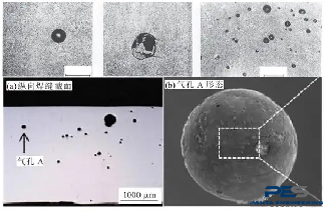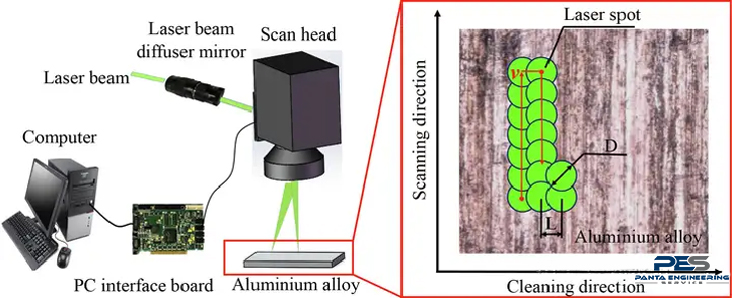Laser welding - analysis of the formation and suppression mechanism of pore defects
Jul 18, 2024Handheld laser welding machines have outstanding welding effects in the field of thin plates, but due to improper operation or imperfect process, pores often occur during welding.
When the laser welding machine is processing, the laser welding machine needs to blow out protective gas coaxially along the optical fiber to prevent the weld from oxidizing or prevent the gas splashing after the material is dissolved from contaminating the lens. The generation of pores is mostly caused by improper use of protective gas or operating errors during laser welding. The reasons for pores in different protective gases are slightly different.
There are two main types of pores in the laser processing process. The following is a detailed description of these two types of pores:
A. Metallurgical pores:
Mainly hydrogen pores, metallurgical pores are caused by changes in the metallurgical properties and composition of the material itself during laser processing.
These pores are usually caused by the following factors:
1. Material impurities: Impurities in the material volatilize at high temperatures to produce gas.
2.Changes in alloy composition: Alloy components segregate during melting and solidification to form pores.
3. Reaction-generated gas: The material reacts with the surrounding environment (such as air or protective gas) to generate gas.
Features:
1. Internal generation: Pores are usually generated inside the material and have little to do with external process conditions.
2. Random distribution: Pores are unevenly distributed and vary in size and shape.
3. Material relevance: Different materials have different metallurgical properties, and the probability and properties of pores are also different.
Impact:
1. Mechanical properties: Metallurgical pores will weaken the mechanical properties of the material, such as reducing strength and ductility.
2. Material consistency: The presence of pores will affect the consistency of the material and cause quality fluctuations.
3. Corrosion resistance: Pores will become the starting point of corrosion and reduce the corrosion resistance of the material.
Solution:
1. Optimize material composition
(1) Use high-purity materials: Reduce the impurity content in the material to reduce the probability of pore formation.
(2) Improve alloy formula: Select appropriate alloy composition and proportion to reduce the possibility of segregation and gas generation.
2. Control material temperature
(1) Preheating and post-heat treatment: Perform appropriate preheating and post-heat treatment before and after laser processing to reduce stress and gas generation inside the material.
(2) Control cooling rate: Avoid excessive cooling to prevent gas from being trapped during solidification.
3. Use shielding gas
(1) Shielding gas selection: Select appropriate shielding gas, such as argon, nitrogen, etc., to reduce the reaction between the material and oxygen in the air.
(2) Gas flow control: Ensure that the flow of shielding gas is sufficient and uniform to cover the entire processing area.
Summary:
1. Hydrogen pores: Hydrogen elements mainly come from moisture carried by surface oxide film, oil stains, impurities, etc., as well as hydrogen carried by the material itself during the metallurgical process, which aggregates into pores; water vapor decomposes at high temperatures, forming a large number of regular circular pores in the weld;
2. Alloy elements: Some alloy elements with boiling points lower than the base material appear segregated and aggregated, and quickly vaporize in the high temperature environment of laser welding to form pore aggregation;
3. Pore characteristics: dense, small, regular round. Energy spectrometer for verification: element testing; preventive measures are mainly incoming material confirmation and surface cleaning.
B. Process-type pores:
Porosity caused by keyhole instability, mainly metal vapor, protective gas, etc. Process-type pores are caused by improper laser processing parameters and operation process.
These pores are usually caused by the following factors:
1. Improper laser parameter settings: unreasonable settings of laser power, speed, focus position and other parameters lead to pore formation.
2. Insufficient protective gas: insufficient protective gas flow or uneven flow leads to oxidation and gas inclusions.
3. Dynamic instability of the molten pool: the molten pool is unstable during the processing process, and the gas cannot escape smoothly and is captured.
Features:
1. External causes: The formation of pores is mainly determined by external process conditions.
2. Strong controllability: By optimizing process parameters and operation procedures, the generation of process-type pores can be reduced.
3. Locality: Pores are usually concentrated in specific areas, which is related to the processing path and process.
Impact:
1. Surface quality: Process-type pores will affect the surface finish and flatness.
2. Processing efficiency: Improper process parameter settings will reduce processing efficiency and increase rework rate.
3. Yield: A large number of process-type pores will reduce the yield and increase production costs.
Solution:
1. Optimize laser parameters
(1) Adjust laser power: According to the material and processing requirements, adjust the laser power to ensure proper melting and gas escape.
(2) Control laser speed: Reasonably set the laser scanning speed to avoid too fast or too slow to ensure the stability of the molten pool.
(3) Focus position adjustment: Adjust the laser focus position to ensure that the laser energy is concentrated in the correct processing area.
2. Improve the use of shielding gas
(1) Optimize gas flow: Ensure that the flow path and speed of the shielding gas are uniform to avoid eddy currents and gas inclusions.
(2) Improve gas purity: Use high-purity shielding gas to reduce impurities and oxygen content.
3. Improve molten pool dynamics
(1) Stabilize the molten pool: Ensure the stability of the molten pool and reduce the formation of bubbles in the molten pool by adjusting laser parameters and processing paths.
(2) Real-time monitoring: Use advanced monitoring technologies, such as optical monitoring and thermal imaging, to observe the dynamics of the molten pool in real time and adjust parameters in time.
4. Reasonable processing path design
(1) Optimized path: Design a reasonable processing path to reduce the laser overlap area and avoid local overheating.
(2) Segmented processing: For large-area processing, adopt segmented processing methods to reduce heat accumulation.
Summary:
It is mainly due to the instability of the keyhole during laser deep fusion welding: From the perspective of the liquid column simulating a small hole in fiber laser deep fusion welding, according to the principle of liquid column stability, when the length of the liquid column is greater than the circumference of its cross-section, the liquid column begins to become unstable, and the upper end begins to show periodic behavior of necking and expansion. As the heat source moves, the necking and expansion of the liquid column collapses under the influence of surface tension and detaches from the keyhole to form bubbles, which are retained in the weld.
Metallurgical pores and process pores are the two main types of pores in laser processing. Metallurgical pores are mainly caused by changes in the metallurgical properties and composition of the material itself, while process pores are caused by improper laser processing parameters and operation procedures. Understanding the formation mechanism and influence of these two types of pores will help optimize the laser processing technology and improve the processing quality.
By optimizing material composition, controlling material temperature, using appropriate shielding gas, optimizing laser parameters, improving shielding gas use, improving molten pool dynamics, and designing reasonable processing paths, the generation of metallurgical pores and process pores can be effectively reduced. These measures can improve the quality and efficiency of laser processing and meet higher processing requirements.
Analysis of bubble causes:

Analysis of bubble escape process:
Whether it is metallurgical pores or process pores, bubbles are formed first and then affected by tension and buoyancy in the molten pool. When the force applied exceeds the threshold, the bubbles will float and escape. As long as they fail to escape before the molten pool solidifies, pores will be formed. Therefore, the condition for pore formation is that the bubble floating speed is less than the molten pool solidification speed, and pores can be formed.

Vf: floating speed; Vs: solidification speed; when Vf < Vs, pores are formed inside the weld; when Vf = Vs, pores are formed on the weld surface; when Vf > Vs, bubbles successfully escape from the molten pool, and pores will not exist.


ρ is the density of liquid metal, η is the viscosity of liquid metal, ρe is the bubble density, g is the acceleration of gravity, l is the bubble radius, L is the escape distance, and t is the escape time. It can be concluded that if you need to exert force in the process of bubble escape, you need to exert force on the viscosity of liquid metal (η). The viscosity is related to the temperature of the molten pool. The lower the temperature of the molten pool, the higher the viscosity. Therefore, how to maintain the temperature gradient change of the molten pool for a longer time is also an indicator that can be optimized.
Suppress the process of bubble generation:
A. Hydrogen pores:
1. The presence of moisture on the surface of the weldment or the increase of O2, H2, and H2O content in the solder wire will increase the hydrogen pores in the weld.
2. During the welding process, when there is no shielding gas or the shielding gas flow is small, some air will be drawn into the molten pool or small holes, which will also increase the content of O2, H2, and H2O in the molten pool, making the tendency of hydrogen pores increase.
3. Hydrogen is difficult to dissolve in liquid metal, and its solubility increases with increasing temperature. When the molten pool enters the solidification stage, the temperature drops rapidly, and hydrogen is easy to precipitate to form bubbles and remain in the weld to form pores.

Solution:
1. Incoming material control: ensure uniform composition, hydrogen content and other indicators.
2. Environmental control: humidity control; surface cleaning of oil, oxides, etc. on the weld surface.
B. Process pores:
1. The core is to maintain the stability of the keyhole, that is, the stability of the welding process, and maintain a dynamic balance with a small range of fluctuations.
2. First of all, the pores are caused by the instability of the keyhole. In view of the characteristics of laser deep melting welding itself, the keyhole stability is almost unsolvable. We can only try to maintain dynamic balance stability. We can stabilize the keyhole by expanding the keyhole opening direction to reduce the fluctuation of the keyhole; we can consider optimizing from the direction of laser composite welding (fiber semiconductor (multi-wavelength) composite, laser arc composite, dual laser, etc.); beam shaping, annular spot, laser forward tilt 5-15°; shielding gas side blowing, etc., and then open a special topic to share technical progress.
3. Maintain the stability of external factors such as environment, mechanism, and shielding gas, especially control mechanism vibration and shielding gas turbulence.
Bubble escape process suppression solution:
1. There are several key parameters: Vf: floating speed; Vs: solidification speed; η is liquid metal viscosity; L is escape distance, t is escape time.
2. Extend the solidification time, reduce the solidification speed, and give bubbles enough time to escape.
3. Increasing the floating speed and reducing the metal viscosity can be achieved by maintaining a reasonable temperature gradient and expanding the molten pool to reduce the cooling speed.
4. The floating distance of bubbles should be reduced as much as possible. It is possible to stabilize the fluctuation of the keyhole so that the depth of the keyhole does not fluctuate greatly, keep the distance stable, and do not suddenly increase, thereby increasing the escape time.
5. Prolong the solidification time and reduce the viscosity of the metal. The molten pool can be kept at a high temperature for a long time through optical fiber semiconductor composite welding, laser arc composite welding, swing welding (8, ∞), etc., which is conducive to the escape of bubbles.
6. Remelting is also a solution.